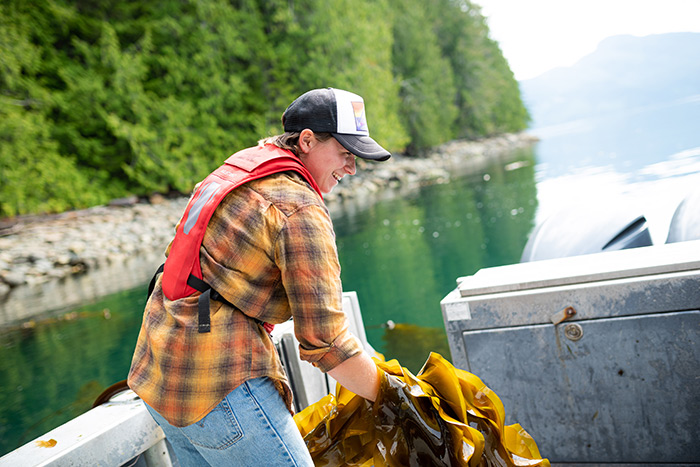Student researcher Sally Enns collects kelp samples in the traditional territory of the Kwiakah First Nation as part of a CARTI research partnership.
NIC Aquaculture Technician certificate alumna Sally Enns got the chance to put her program knowledge to work as a research assistant on a new partnership between NIC’s Centre for Applied Research, Technology and Innovation (CARTI) and the Kwiakah First Nation.
The partnership involves wild kelp bed research along the First Nation’s territory.
Lead researcher Allison Byrne worked part-time as one of Enns’ instructors and offered students the opportunity to join her research team.
“I just jumped on it instantly because I heard all the stuff she does with kelp research and I thought that was so cool,” said Enns.
Enns found NIC’s Aquaculture program while doing her final year of her undergrad in geography in Victoria.
“I took an aquaculture class at UVic and the instructor also did work with NIC in kelp research,” she said. “He told us all about the cool stuff that’s happening in the aquaculture industry and how species can help each other. It’s so much more than I thought it was.”
After finishing her undergrad, Enns enrolled in the Aquaculture Technician certificate where she had the opportunity to do the field research, going out on a boat around the inlets along the survey route, collecting data on how much kelp was present.
This year was a bad year for kelp, as a lot of the bull kelp had died and disappeared from areas where it once was abundant.
“This research was part of a push to start monitoring that and making sure the stocks don't decline past the point of no return,” said Enns. “People are becoming more aware how valuable kelp is, not only is it a resource for food products, cosmetics, but also as an ecosystem service, such as a habitat for juvenile salmon, a buffer against erosion from the ocean, and things like that.”
There isn’t much data on the biomass along our coast, noted Enns, and it was exciting to be a part of helping to gather that data.
“We had a quadrat—one meter by one meter pipe square and in that square we would count how many stems of kelp there were,” said Enns. “We would get data on the lengths of the blades, and get all these different measurements to estimate the biomass and then we would record all that data.”
Now completed her technician certificate, Enns is excited to join the industry and see where the aquaculture sector grows from here. Her experience as a research assistant has inspired her to continue seeking opportunities to be involved in innovative aquaculture projects.
“I’m super interested in the newer alternative species being explored in aquaculture right now,” said Enns. “Newer shellfish species, such as geoduck, sea cucumbers, and sea urchins. There’s more and more companies exploring those things now, so I want to get more work experience, see what’s out there, and see where there needs to be new research and innovation.”
For more information on CARTI’s current research projects, visit www.nic.bc.ca/research
For information on NIC’s Aquaculture programs, visit www.nic.bc.ca/trades.
Media Contact C: 250-207-6946 media@nic.bc.caRead more about the Kwiakah First Nation Kelp Research.
The research partnership was also featured in Maclean's Magazine: Why colleges in Canada are 'hard-wired' to the communities that surround them
